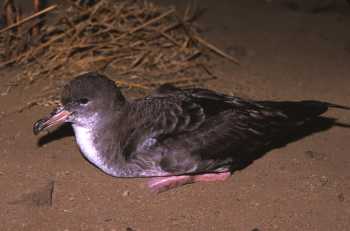Along with eight other shearwaters of the genera Calonectris and Puffinus, the Pink-footed Shearwater P. creatopus, a trans-equatorial migrant in the Pacific Ocean, has been identified as a potential candidate for inclusion within the Albatross and Petrel Agreement. This is because of the risks it continues to face at sea from fisheries and on land from introduced predators, breeding habitat degradation and, at one colony human exploitation of chicks (Hinojosa & Hodum 2007, Cooper & Baker 2008, Cooper 2010).
The species, a Chilean breeding endemic categorized as Vulnerable has been listed in Appendix 1 of the Bonn Convention on Migratory Species (CMS).
A collaborative group from Canada, Chile, Mexico and the USA is working together with the Juan Fernández Islands Conservancy (JFIC), a programme of Oikonos Ecosystem Knowledge, to study and conserve the Pink-footed Shearwater (see http://www.pinkfootedshearwater.org/index.html and http://www.oikonos.org/projects/fardela.htm).
Pink-footed Shearwaters are being tracked at sea during both the breeding season and migratory and wintering periods by JFIC/Oikonos. Results are publicly accessible at the Wildlife Tracking Project website.
Several international and domestic (Canada and Chile) Action Plans or equivalent documents exist for the Pink-footed Shearwater (COSEWIC 2004, CEC 2005, Hinojosa & Hodum 2007, Environment Canada 2008).

Selected recent publications on Pink-footed Shearwaters:
Commission for Environmental Cooperation 2005. North American Conservation Action Plan. Pink-footed Shearwater Puffinus creatopus. Montreal: Commission for Environmental Cooperation. vii + 49 pp. http://www.cec.org/Storage/59/5164_NACAP-Pink-footed-Shearwater_en.pdf.
Committee on the Status of Endangered Wildlife in Canada 2004. COSEWIC Assessment and Status Report on the Pink-footed Shearwater Puffinus creatopus in Canada. Ottawa: Committee on the Status of Endangered Wildlife in Canada. vii + 22 pp. www.sararegistry.gc.ca/status/status_e.cfm.
Cooper, J. 2010. A brief review of the conservation status of shearwaters Calonectris and Puffinus. ACAP AC5 Inf 15. http://www.acap.aq/english/english/advisory-committee/ac5/ac5-information-papers.
Cooper, J. & Baker, G.B. 2008. Identifying candidate species for inclusion within the Agreement on the Conservation of Albatrosses and Petrels. Marine Ornithology 36: 1-8.
Environment Canada 2008. Recovery strategy for the Short-tailed Albatross (Phoebastria albatrus) and the Pink-footed shearwater (Puffinus creatopus) in Canada. Species at Risk Act Recovery Strategy Series. Ottawa: Environment Canada. vii + 46 pp. http://dsp-psd.pwgsc.gc.ca/collection_2008/ec/En3-4-56-2008E.pdf
Guicking, D., Fiedler, W., Leuther, C., Schlatter, R. & Becker, P.H. 2004. Morphometrics of the Pink-footed Shearwater (Puffinus creatopus): influence of sex and breeding site. Journal of Ornithology 145: 64-68.
Guicking, D., Ristow, D., Becker, P.H., Schlatter, R., Berthold, P. & Querner, U. 2001. Satellite tracking of the Pink-footed Shearwater in Chile. Waterbirds 24: 8-15.
Hinojosa S., A. & Hodum, P. (Eds) 2007. Plan Nacional para la Conservacion de la Fardela de Vientre Blanco Puffinus creatopus Coues, 1864 en Chile. Corporación Nacional Forestal & Comisión Nacional del Medio Ambiente. 34 pp.
With thanks to Peter Hodum for information.
John Cooper, ACAP Information Officer, 26 November 2010

 English
English  Français
Français  Español
Español